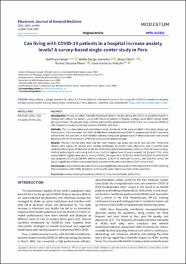| dc.contributor.author | Moya-Salazar, Jeel | es_ES |
| dc.contributor.author | Saciga-Saavedra, Walter | es_ES |
| dc.contributor.author | Cañari, Betsy | es_ES |
| dc.contributor.author | Chicoma-Flores,Karina | es_ES |
| dc.contributor.author | Contreras-Pulache, Hans | es_ES |
| dc.date.accessioned | 2022-11-17T16:41:38Z | |
| dc.date.available | 2022-11-17T16:41:38Z | |
| dc.date.issued | 2022-06-03 | |
| dc.identifier.uri | https://hdl.handle.net/20.500.13053/7135 | |
| dc.description.abstract | “Introduction: Anxiety can affect front-line healthcare workers (HCWs) during the COVID-19 pandemic mainly in settings with influencing factors. Living with COVID-19 patients in hospital settings could affect mental health during lockdown. The present study aimed to estimate the anxiety levels of HCWs of the care center for COVID-19 Villa Panamericana during the first outbreak of COVID-19 in Peru.
Methods: This is a descriptive and correlational study. Ninety-six HCWs were enrolled in this study (mean age 30±5.6 years). The care center for COVID-19 Villa Panamericana houses COVID-19 patients and HCWs in the same environment. We used the 14-item Hamilton anxiety rating scale questionnaire. Professionals were interviewed directly at the VP-19 rest towers. SPSS V.23 were used to analyze the data.
Results: Fifty-four (56.3%) were male and the most frequent age group was 26-35 years (81.3%). Thirty-nine (40.6%) were nurses, 28 (29.2%) were nursing technicians, 15 (15.6%) were physicians, and 14 (14.6%) were medical technologists. Of the total, 66 (68.8%) HCWs had a mild level of anxiety, while 6 (6.3%) had severe anxiety. Medical technologists and nursing technicians had the highest level of severe anxiety (14.3% and 7.1%), while nurses had the highest level of mild anxiety (76.9%). We report that 32 (33.3%) HCWs had COVID-19 while 93.7% had symptoms of anxiety [3(9.4%) mild to moderate, 21(65.6 %) moderate to severe, and 6(18.8%) severe]. We found a significant difference in anxiety levels between HCWs with and without COVID-19 (p=0.001).
Conclusions: Levels of moderate and severe anxiety significantly increased in HCWs infected with COVID-19 during their coexistence with COVID-19 patients in the health center that houses both at the same time.“ | es_ES |
| dc.format | application/pdf | es_ES |
| dc.language.iso | eng | es_ES |
| dc.publisher | Modestum LTD | es_ES |
| dc.rights | info:eu-repo/semantics/openAccess | es_ES |
| dc.rights.uri | https://creativecommons.org/licenses/by/4.0/ | es_ES |
| dc.subject | " anxietyhealth professionalsCOVID-19Perumental healthSARS-CoV-2" | es_ES |
| dc.title | Can living with COVID-19 patients in a hospital increase anxiety levels? A survey-based single-center study in Peru | es_ES |
| dc.type | info:eu-repo/semantics/article | es_ES |
| dc.identifier.doi | https://doi.org/10.29333/ejgm/12140 | es_ES |
| dc.type.version | info:eu-repo/semantics/publishedVersion | es_ES |
| dc.publisher.country | GB | es_ES |
| dc.subject.ocde | http://purl.org/pe-repo/ocde/ford#3.03.00 | es_ES |


